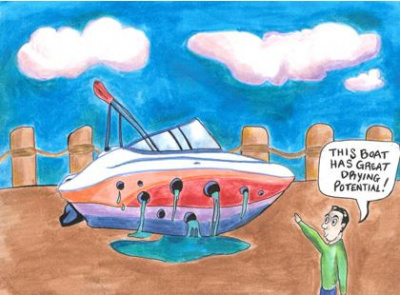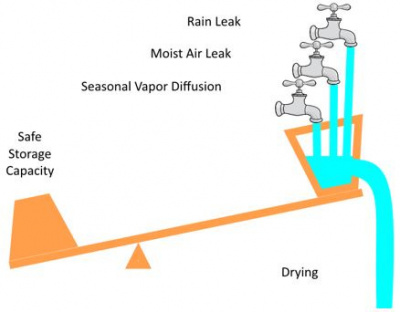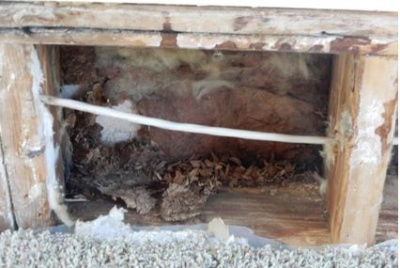
Illustration by Hunter Lane, Applied Building Technology Group
For a boat hull, it is best to essentially eliminate wetting potential with the use of a highly water- and vapor- resistive hull, or at least outer coating on the hull, right? In this case, drying potential is easily handled on the interior side by use of a small bilge pump or bailer.
Exterior walls of buildings are a bit trickier, but similar in principle. First and foremost, wetting potential from rain water must be minimized by proper use of a water-resistive barrier and best-practice flashing details at all windows, doors, and other penetrations.
Any reasonable approach to or amount of drying potential will not offset major water-resistance defects that result in excessive wetting potential from rain water intrusion. For example, if a boat has holes in the hull the approach of installing a larger bilge pump (aka, more drying potential) to remove the water may in some cases keep the boat afloat temporarily, but it is not going to make it seaworthy. Fix the holes. Similarly, trying to rely on high drying potential (rather than focusing on fixing the holes or water leaks) can lead to increased wetting potential from inward water-vapor movement for reasons given earlier. The three stooges make some fun of this point. Don’t be a stooge.

Figure 1. The Drying Potential Balancing Act
For drying potential of a building’s walls, one must be careful to allow adequate vapor movement out of the assembly, but not in a way that allows a lot of vapor movement back into the assembly under changing seasonal conditions. This can be a challenging balancing act (see Figure 1) that depends on a number of factors, including the cladding material used, the climate zone where the building is located and the vapor permeance of building material and insulation layers making up the wall assembly.
Consequently, a safe and simple design approach for building a sound wall assembly is to use a moderate- to low- vapor permeance material layer on the exterior of the wall and let the wall breathe to the interior by use of a moderate- to high- vapor permeance interior vapor retarder, such as a Class II (Kraft paper), Class III (latex paint) or a “smart” vapor retarder. This approach works well because the water-sensitive interior portions of a wall become influenced by a more stable indoor environment and are protected from the variable outdoor conditions that otherwise create episodes of wetting and drying. Also, the balance of wetting and drying potential with adequate inward drying minimizes moisture cycling of materials within the wall. This is good for the structure. This is good for durability. This is good for water sensitive materials within walls such as wood-based or gypsum sheathings. This is simple, but it must be done right…
While the above inward-drying approach can work in any climate, in colder climates the wall must be “tricked” into thinking it is in a warm climate to control humidity levels with the assembly and prevent condensation or moisture accumulation within the wall during the winter months. This beneficial effect is easily and reliably achieved by using a sufficient amount of continuous insulation, like foam sheathing, on the exterior of the building as is often required to comply with modern energy codes.
In fact, a wall calculator tool and educational aids have been developed for this purpose. Foam plastic insulations, like plastics commonly used for boat hulls, also have a comparatively high level of durability when exposed to water, which can be further enhanced by facers (like the gel coat on a boat hull). With these moisture control and durability benefits, energy savings are also obtained by envelope insulation of the entire exterior of a structure, including all the thermal bridges created by wood and, to a much greater extent, steel framing members.

Conversely, walls with no exterior continuous insulation result in cold materials within the wall (such as wood-based or gypsum sheathing) and this tends to create high humidity or condensation conditions that increase the moisture content of these materials during the winter, which can lead to moisture related and durability issues. Even with high exterior drying potential leading to drying in the Spring and Summer, the moisture cycling in the winter may lead to potential moisture damage unless a low-perm interior vapor barrier is used and careful air-sealing applied to prevent vapor diffusion and warm indoor air leakage into the wall. Also, in warm-humid climates, a high outward drying potential really means that during much of the year there is high inward wetting potential due to inward vapor diffusion. In this case, focusing instead on inward drying and avoiding high vapor permeance materials on the exterior is a favorable practice.
So, don’t be fooled by narrowly focused claims that foam sheathing creates low drying potential without considering the fact it can significantly reduce and control wetting potential while, together with appropriate vapor retarder selections, also provide appropriately balanced and inwardly directed drying potential for a durable and energy efficient wall assembly suited for any climate.
Water Resistant Barriers Topical Library on Continuousinsulation.org
For additional information, review the following articles, as well as the previous videos in this series:
Perfect Wall Articles
- Creating the ‘Perfect Wall’: Simplifying Water Vapor Retarder Requirements to Control Moisture
- Perfect Walls are Perfect, and Hybrid Walls Perfectly Good
- Wood Framed Wall Insulation Calculator Explained
- New Wall Design Calculator for Commercial Energy Code Compliance
- Energy Code Math Lesson: Why an R-25 Wall is Not Equal to a R-20+5ci
- Continuous Insulation Solves Energy Code Math Problem
Video Series
- Fear Building Envelopes No More with This Website & Videos
- Video: Thermodynamics Simplified Heat Flows from Warm to Cold
- Video: Moisture Flow Drives Water Induced Problems
- Video: How the 'Perfect Wall' Solves Environmental Diversity
- Video: How Important Is Your WRB?
- Video: A Reliably Perfect Wall Anywhere
- Video: The Best Wall We Know How to Make
- Video: How to Insulate with Steel Studs
- Video: Thermal Bridging and Steel Studs
- Video: Better Residential Energy Performance with Continuous Insulation
- Video: How to (Not) Ruin a Perfectly Good Wall
- Video: Tar Paper and Continuous Insulation? No Problem!
- Video: Do CI and WRBs Go Together?
- Video: Assess Your 'Perfect Wall' Using Control Layers